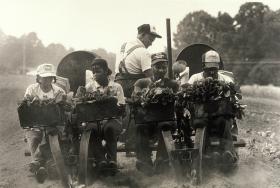1. To prepare the class, lead a discussion about the history of tobacco in North Carolina from the colonial era to today and documentary photography. Using Rob Amberg's Jim Smyre and family planting tobacco as a primary source, have students discuss the following:
- What is meant by the word “documentary”? How is a photograph a primary source? Why do you think the photographer was drawn to this subject matter?
- What time period is documented? (1987) How do you know? (date given with photograph information)
- Where is the scene located? (Piedmont region, rural Iredell County, N.C.) How do you know? (relatively flat terrain with no signs of mountains, location given on photograph)
- What social class or economic level do you think the subjects belong to? Why? (small-farming family shown, working class)
- What technology is available? (tobacco setting machine) How would this scene look different at various times (from the colonial period to today) in North Carolina history?
2. As a class, speculate about the subjects’ daily life. How are their lives influenced by tobacco? Have students work together to create an outline with suggestions for a narrative written by one of the people in the photograph as a companion to the image.
3. Have students pair up and have each student select a role with your guidance: writer or artist. For each pair, gather slips of paper with concise character descriptions consisting of time period and occupation, and place them in a hat or bag for students to draw assignments. Characters should represent the colonial period, late 19th or early 20th century, Depression era, post-World War II to 1980s, and the present day. Characters should come from diverse occupations, such as planter, small farmer, migrant worker, tobacco executive, cigarette factory worker, and medical researcher.
4. Have the writer and artist on each team outline their roles; each should contribute to the vision of the project, but they will split the responsibility of communicating with written and visual language. Have them research the assigned historical periods and occupations to determine how tobacco has affected the growth of agriculture as an economic industry, the evolution of technology, changes in society and the workforce, regional development, and other endeavors such as medical research. Additional primary sources the students can use include William Byrd's Westover Manuscripts and an 1896 agricultural report [links at bottom].
- Tell each writer to produce a three-to-four-paragraph narrative featuring the assigned character’s point of view on how the tobacco industry affects his or her life in North Carolina. Instruct students to create the character incorporating ideas from their research. Give each writer a Character Planning Worksheet and cause-and-effect chart to organize this information.
- Have the artist use the team research from the character planning worksheet to determine how to best complement the narrative. Possibilities could include an illustration, a documentary photograph similar to Amberg’s, an advertisement for tobacco, or a public health poster.
- After creating drafts of the narrative and image, team members will suggest revisions to each other to work toward a final image and narrative.
- Teams will present their narrative and image together, combined with a group discussion about the variety of perspectives on the topic.
- As a class, create a “then and now” chart to document changes in the perception of tobacco over time. Compare the subtopics explored by the students in their research. Have students suggest additional subtopics.
5. Compile the narratives and images in a class book.
- Student research and graphic organizers, such as the then and now chart, may be used to determine students’ understanding of issues surrounding tobacco in North Carolina history, from past economic impact to ongoing changes in the industry.
- Character charts, narratives, and images will demonstrate how successfully the students have applied their research to developing a character point of view through details such as setting, description, voice, and contextual details.
Character Planning Worksheet (see download below)
In his ongoing series Vanishing Culture of Agriculture, Rob Amberg documents the effects of change and technology on small family farms. For over 25 years, Amberg has visited small farms throughout the South and captured farmers and their families at work and at play. Jim Smyre and family planting tobacco shows a family riding a tobacco setter as they transplant seedlings into the field.


